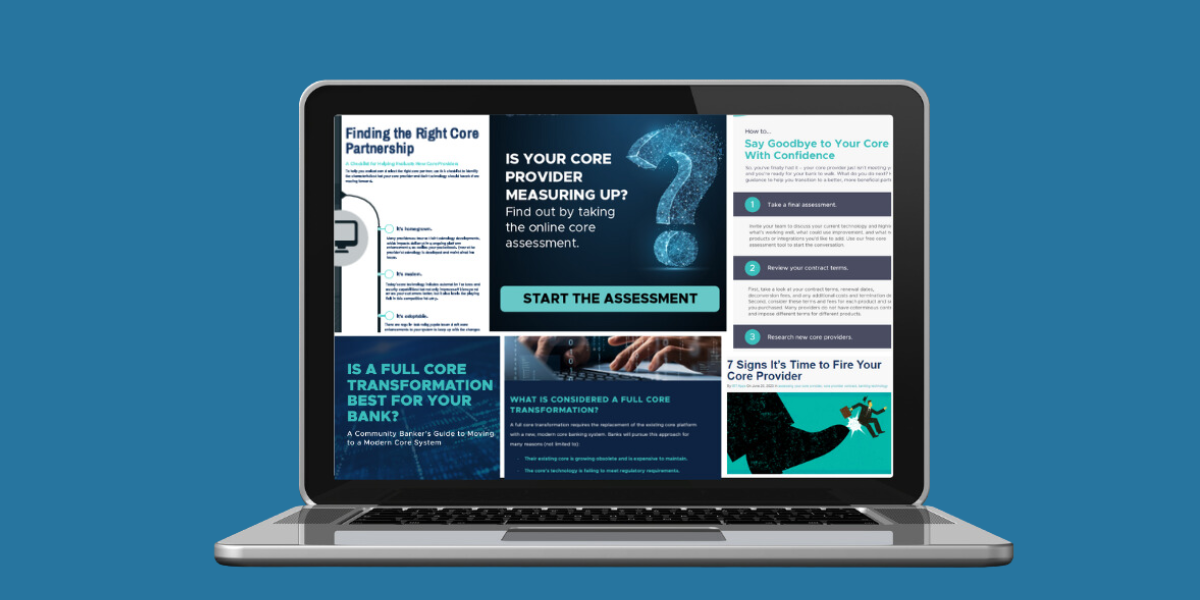Your relationship with your core provider has seen better days. Whether you've had your core for a few years or a few decades, you can probably remember when things started going sour. They were attentive and responsive at first, but then service started waning and they stopped delivering on their promises. Their technology was also “state-of-the-art” when you purchased it, but now it’s old news, barely hanging on, or you’ve simply grown out of it. Either way, your core isn’t in your corner like they used to be or (if you’ve recently invested in a new core) perhaps they never were.
If you’re reading this article, then you’re definitely thinking about letting go of your core provider. You just may not be ready to do so. For this reason, we are providing the tell-tale signs to validate you and give you the encouragement to fire your core provider.
1. You’re paying for applications and integrations you’re not using.
It’s great if your core provider releases new products and announces new integration partners routinely, but you shouldn’t be billed for those offerings, especially if you’re not using them. Not sure if you’re being billed for unused software or services? Pay close to attention and compare your invoices. Any cost increases should be self-explanatory, but if they’re not, make sure to contact your account manager.
2. You’re submitting a support ticket more frequently.
If it’s not one thing, it’s another with your technology. One day, it takes longer to pull up account information. Another day, your screen freezes when generating a simple report. And every time something happens, you have to submit a ticket and hope that someone gets back to you promptly and can fix the issue(s). You shouldn’t have to constantly deal with support issues.
3. You’ve started managing IT instead of your business.
So, take the above item about support issues and take it up a notch. Your team is submitting tickets constantly, but there’s a slow response from your provider to resolve issues, so you have to step in or risk losing another day of productivity. Worse yet is when your provider says they can fix the problems, but it will come at a cost. If you’re busy fighting IT fires and making sure your technology is operating as it should, then who’s running the business and serving your customers?
4. Service interruptions have become normal.
It’s not normal to have system interruptions regularly, so if your customers are not able to access their bank accounts when they need to or your systems freeze or shut down often, then that’s a problem and could even lead to compliance violations for your bank. A good core provider and their integration partners will try to avoid running system updates during business hours, or even better, have a business continuity plan a place to keep your technology running at all times even when initiating updates to your systems.
5. You hit roadblocks when adding on more products.
You’ve requested to add on another product or integration, but have only walked away disappointed. Either your core provider doesn’t offer the product/integration, or if they do, it’ll cost you more than you expected, or the delivery time is plain outrageous. It shouldn’t take months to add a product to your current system. Additionally, addendums to your master agreement can be complex in nature and if they’re not coterminous with the master agreement, you can end up managing different terms for different products.
6. Your best customers are closing their accounts.
If lagging systems aren’t enough to irritate your customers and send them running to another bank, lack of new offerings and innovations will. Afterall, this is the era where customers are looking for technology that makes banking more convenient. So, if your core provider isn’t in tune with the latest banking technology that gives your bank the competitive edge, or even worse, they’re no longer making updates to their system, there is a chance that even your most loyal customers are at risk to make a switch.
7. Your bank isn’t able to grow due to friction with your core.
“Growing” takes on two meanings. 1.) You’re looking for revenue opportunities in your technology, and your core provider should have solutions, but they don’t have offerings like Banking as a Service, and you just talk past each other when it comes to new APIs and integration partners. 2.) You’ve acquired or merged with another bank, but now you’re having issues putting the other bank on the same core system. That and the merger/acquisition costs and ongoing service fees are unclear, so you’re not exactly sure how much you’re paying to grow your business.
Transitioning to a Modern Core Platform – Where to Start
Realistically, it may not make sense to switch core providers right away, depending on your budget, resources, and your existing core contract. But, if you decide that you will be letting go of your core provider (just not tomorrow), there are some things you can do to prepare for the big moment.
1. Take an assessment.
Document all of the issues your team has been having with your core technology and make a wish list that sets up your desired, future state. Not only does this include worry-free technology and stress-free service, but also new products to add to your offerings.
Take the IBT Apps core assessment and see the gaps in your existing provider’s service.
2. Learn more about modern core banking systems.
Core banking technology has evolved tremendously, and you may not know about what’s available to you or just what it means to be “modern” because you’ve been stuck with an aging core. Do your research on modern core banking technology and see your options.
Read about modern core technology on our website.
3. Weigh your options.
If you’re bank is running a decades-old system, we advocate for a complete core transformation. However, we understand if you’re bank isn’t ready for it. Know that you have other strategies to consider that can help modernize your core.
Read our blog article on Core Modernization: 3 Strategies for Banks to Consider and learn more about full core transformation when you download the ebook.
4. Reach out for guidance.
After exploring your core options, you still may not know what works best for your bank and/or how to prepare to make the eventual switch, and that’s ok. We know there’s a ton of variables to think about, technically, operationally, and financially. We just want to say that even when you’re unsure which direction to venture into, you can reach out to us to talk through what’s on your mind.
We’ll listen to your pain points, needs, and concerns and offer a solution or solutions that will work best for your bank. Not sure what your bank needs? That’s ok too; we’ll assess your systems, get your input and feedback, and collaborate on the solution. Interested in switching cores now, but locked into a contract with your current provider? We’ll work with you to discuss your options and work with you on a technology transition plan that makes sense for your bank.
Connect with us when you’re ready to discuss. We’d love to hear from you.






